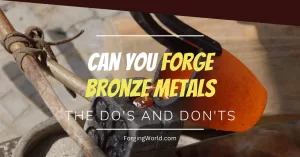With all the techniques used to clean, sharpen, and polish metal, sandpaper seems like the do-it-all solution. I’ve often wondered what’s the best and simplest tool to use on swords and other blades.
It’s difficult to say if sandpaper is a great option for swords right away, it’s certainly a viable one. You can achieve anything with it if you do it right, but it won’t always be the simplest or the cheapest thing to use. However, in most situations, it’s the most beginner-friendly thing to use, and to further explain it, we need to dive into details.
Everything you may need to do the things I talk about in this article:
- Sandpaper 120-5000 grit pack
- WD-40
- LAVODA Leather strop
- Simichrome 390050 All Metal Polish
- Microfiber Cloth for Stainless Steel
- Dremel 3000-1/24 Variable Speed Rotary Tool Kit
Some of the things mentioned are required only in certain situations, so make sure to read where and when exactly I’ve used them.
Without further ado, let’s talk about how you can and should treat your swords using sandpaper.
Silicon Carbide vs. Aluminum Oxide Sandpaper for Swords
With most carbon steel, aluminum oxide sandpaper will perform better than silicon carbide. Both sandpaper types will grind the steel equally, but silicon carbide will quickly wear out because it’s brittle.
When grinding steel with a high amount of chromium, vanadium, tungsten, and so on, silicon carbide performs better because it’s harder than aluminum oxide. Both wear out quickly, but due to their hardness, silicon carbide is more abrasive.
Both can be used on swords and similar steel objects if your goal is only to polish with a high grit, including getting rid of fairly new and extremely shallow rust spots.
The rust that develops on steel is softer than the original metal. You will grind through thin patches of rust with ease using high-grit silicon carbide sandpaper while preserving almost all of the metal underneath. However, the aluminum oxide will create a smoother finish because it keeps consistency due to its durability.
If you don’t know which steel the blade is made from, it’s better to start with aluminum oxide sandpaper. If it’s not grinding anything away, switch to silicon carbide sandpaper.
For most purposes, you can use either one to get the same results. In the end, the only real difference when hand-used is that silicon carbide sandpaper works faster but requires changing to a new piece of sandpaper more often.
Wet vs. Dry Sandpaper for Swords
The story between wet and dry use of sandpaper is similar to the two different types of it. Except, the effect is less exaggerated towards loss of abrasiveness and more towards getting smoother finishes.
Using wet sandpaper, specifically with water displacing oil like WD-40, achieves a similar effect as using silicon carbide sandpaper on steel, but better. The only downside is that oils can leave a distinctive smell and require careful cleaning.
Water, on the other hand, is somewhat in between dry and oil in terms of effectiveness. However, I find it unnecessary for anything except sharpening when working with steel.
Oil is simply better for steel in all situations other than sharpening, especially if you finish the grinding with lower-grit sandpaper and don’t want to polish in the end.
Can You Remove Rust From Swords With Sandpaper?
As I mentioned above, small patches of rust and especially fresh rust that didn’t have time to penetrate too deep can be easily removed with any type of sandpaper.
Sandpaper is actually a perfect tool for the job, as any electric-powered grinder will heat the metal enough that it becomes even more vulnerable to rust later on.
Stages of Sword Rust vs Sandpaper
I should mention that steel rust typically has three stages.
The first stage is when smaller patches appear. The rust is shallow and can be easily removed.
The second stage is a bit more problematic because that is where the invasiveness deep into the steel’s surface happens. You will have to decide if it is worth removing the rust or not. It might be the case that you will have to thin the blade so much that it won’t keep its form.
Stage three is why keeping a blade rusted is even an option because it forms a protective layer in which rust equalizes around the surface and stops being progressive. Removing the rust will make a blade so thin it won’t be useful at all. Unless it’s a wall-hanging sword, which is often made from stainless steel anyway and wouldn’t put you in this situation.
Personally, I like to keep the rust and get to that antique look once a blade is halfway through stage two. Especially considering if I thin the blade too much and the rust appears ever again, I won’t have a sword anymore.
My final answer is yes, you can always remove rust from swords using sandpaper, but sometimes you shouldn’t.
How To Remove Rust From Swords Using Sandpaper
The “how-to” process of removing rust from steel depends on how severe the rust is.
For the sake of the explanation, I will divide the rust severity into three categories; shallow surface rust, medium progressive rust, and severe rust.
Let’s start with the severe rust as it is the worst-case scenario.
Sanding Severe Rust off a Sword
Removing severe rust requires sandpaper with a lower grit and will consume a lot of your energy. One might think that a power tool is a good substitute for their own effort, but one would be wrong.
One of the rules when removing rust, sharpening, or polishing a blade is to never heat it up. A power tool and grit required to remove a thick layer of rust will heat the blade so much that the steel changes its properties. Heated steel becomes weak and even more susceptible to rusting.
Instead, I recommend starting with 40-100 grit sandpaper, depending on the rust severity. The rust grinds away faster at this point when dry sanding, but the dust makes it difficult to work, so I prefer wet sanding from the very beginning.
You can use water or some type of low-viscosity oil. I used WD-40 since I first dealt with rust and never looked back.
All you need to do is keep going until you see clear metal beneath and change to a higher grit as soon as you do. You want to avoid creating deep scratches in the “good” steel. They are not a huge problem, but they take time to sand away to a clear finish.
I like to move to 200-400 grit sandpaper for some time after that.
Once the surface becomes clearer, keep increasing the sandpaper grit to smooth out the lines.
When dealing with severe or progressive rust, you might need to leave some hole-like rust dots. Otherwise, you will thin the blade way too much. I would recommend looking for them early on and judging the situation by yourself.
If the surface is flat without rusty holes, switching to higher-grit sandpaper sooner will save you time in the long run.
However, if you want to grind away every tiny little dot, switching to higher grit sandpaper prematurely will prolong the process.
Sanding Progressive Rust off a Sword
Progressive rust might be only on the surface or penetrate a bit deeper. The problem is it’s difficult to know until you reach a certain point during the sanding process.
I always try wet sanding with higher-grit sandpaper first, just in case it’s still very shallow rust that can be easily removed. That way, you will preserve the finish to some degree and spend less time polishing it in the end.
800-1200 grit sandpaper is what you want to test it with. If the rust is still present after a few minutes of sanding, the rust is a bit deeper, and it will require lower grit sandpaper.
I prefer a sandpaper grit of around 400 whenever I identify medium progressed rust.
Even though the rust is likely to be in patches at this stage, you need to sand the whole surface equally to avoid getting an uneven surface. Also, the polishing will be easier when starting from an evenly scratched surface.
All you need to do now is continue sanding while lowering the sandpaper grit until you reach a reflective finish with no scratch marks. Then you can polish the blade to get a true mirror finish or leave it as is.
Sanding Shallow Rust off a Sword
To remove shallow rust spots from a steel blade, you want to try the step mentioned above using 800-1200 grit sandpaper and some WD-40.
I lightly sand only the spot where the rust is because if it’s really shallow rust, I won’t create any low spots on the surface.
From there, the process is the same as written above in the progressive rust stage, except you may get away with polishing only the places where the rust was. If you don’t get an even finish, sand the whole blade with 2000 grit sandpaper to even out the surface and continue from there.
Alternatively, surface rust can be removed using a rotary Dremel tool, a felt wheel, and a polishing compound. Using it at a lower speed won’t generate enough heat to change the steel’s properties because a felt wheel is very soft and has low friction.
That way, you can easily even out the whole surface while removing rust and creating a reflective finish at the same time. Unfortunately, it works only if you catch rust at its very early stage.
Can You Sharpen Swords With Sandpaper?
Swords can be sharpened with sandpaper. However, due to the curvature and longness of the blade, whetstones are a more popular option. To make sandpaper easier to use, it needs to be put on a block-type object. That will allow you to keep a consistent angle and have precise movements along the blade.
Sharpening swords with sandpaper is a more situational technique. For example, putting sandpaper on a squishy surface will allow you to form a convex edge.
A popular choice is a mousepad that doesn’t have a hard layer on top, although I didn’t find it that great. Mousepads are too soft, and you can’t really press on them too hard, which makes sharpening last too long.
Leather straps are far better because they are not that squishy, so you can put a lot of pressure on the blade.
How To Sharpen a Sword With Sandpaper
There are many different edges, all requiring different techniques. I will focus on the two, in my opinion, best suited for swords; a v-shaped edge and a convex edge.
How to Sharpen a V-Shaped Edge
Sharpening a v-shaped edge is quite simple. I start with several woodblocks, each with its own sandpaper grit. 4 blocks with 400, 800, 1200, and 2000 grit sandpaper in most cases.
I use 800+ grit for resharpening edges in an average condition. Anything lower than that is reserved for extremely dull edges.
Before talking about the technique, I should mention that sharpening is best done by wet sanding with water. Some people might have different opinions on this, but wet sanding with water is the most widespread technique for a number of reasons.
The common mistake is that people place a part of the edge on sandpaper and grind it back and forth. You don’t want to do that, ever. The whole length of the edge must slide over the sandpaper on each pass.
It takes a bit of practice because you need to follow the curvature, especially at the tip, while keeping the desired angle at the same time.
A good way to practice is to use a marker and paint the edge to see what you are grinding off with each pass and adjust the angle based on where the marker got erased. It’s how I first practiced and it worked great.
There is no right or wrong answer when it comes to angle degrees. The basic principle is that narrow angles make sharper edges that get dull easily, while wider angles are not as sharp but stay sharp for long.
You can switch the side after each pass or alternate between 2-3 passes on each side. I usually do 1-bys with a lower grit and increase the number of passes as I progress through higher grit sandpaper.
How to Sharpen a Convex Edge
To get a sharp and durable convex edge, you need to perceive the blade’s curvature and be able to move it over the sandpaper smoothly.
Sharpening has a lot of knowledge to learn and practice to do. The best way to get great results without learning too much theory is to have the right tools for the job and work on your consistency when pressing down on the blade.
That’s why I never liked using sandpaper with mousepads to sharpen a convex edge. The consistency of pressure is unreliable due to how squishy mousepads are.
I use a custom-made leather strop because I wanted a big one for swords, although I’ve used a few ones from Amazon before, and they were quite decent at sharpening knives and swords.
I found LAVODA Leather Strop 3″ by 15″ to be the best for swords because it is slightly bigger than the average leather strop for knives.
I put the sandpaper over the leather to sharpen the convex edges. Choosing the grit of the sandpaper follows the same logic and procedure as described in the previous chapter; 400, 800, 1200, and 2000.
Make sure the sandpaper is fixed in place because otherwise, it will start moving when the blade goes over it, and you won’t get an evenly sharp edge. I wrap the sandpaper firmly around the strop and use duct tape on the bottom side to hold it together.
You can sharpen the edge on watered sandpaper, increase the grit along the way, or finish it on the leather. You will get a sharpening paste with the leather strop, which acts as a very fine grinder/sandpaper when put on the leather.
The main difference from other sharpening techniques is that you can’t push the blade forward. You need to pull the blade away from the edge.
The angle is a bit easier to follow because the leather has just the right amount of flexibility so that any small inconsistencies are almost irrelevant. Although you still need to be as close to the right angle as you can.
The best way to check the angle is to push the blade a bit forward and see if it digs into the leather or sandpaper. If it does the angle is too high.
Can You Polish Swords With Sandpaper?
Sandpaper is required when polishing any material. However, depending on how “mirror-like” you want the surface to be, you might need to use a polishing paste and a polishing cloth. Unless you want to just repolish steel a bit, sandpaper is actually a necessity. Most scratches on the steel surface can’t be removed without sandpaper.
You will notice that using sandpaper on steel doesn’t always leave a reflective finish even after using a polishing cloth and paste. There are two reasons for that.
- Not all types of steel can be polished to an equally good-looking mirror finish.
- Improper technique.
How Do You Polish a Sword Using Sandpaper?
Polishing steel is the same as any sanding, including rust removal and even sharpening, except you need to increase sandpaper grit more slowly and alternate directions.
Basically, I include more fine-grit sandpaper varieties if I want to polish a sword at the same time while sharpening or removing rust.
For example, instead of the usual 800, 1200, and 2000 grit when removing rust, I will include 1000, 1500, and 1800 in between. Then I progress to 3000 and 5000-grit sandpaper to make the blade’s surface really smooth.
To avoid having unequal areas on the surface, make sure you sand the whole surface equally before progressing to the next grit.
Even if the rest of the sword is polished, you want to sand it all over because otherwise, you will always be able to see the difference between the two areas.
The key to a really shiny polish is to change the sanding direction each time you change the sandpaper grit. I alternate the sanding direction at 90 degrees, which gives amazing results every time.
When you want good polish, wet sanding is quite important. I found that oil gives better results than water, but it’s more difficult to clean. Especially if you are going to finish polishing with polishing paste and cloth, which requires the surface to be perfectly clean.
To Sum It Up
Rust removal:
- Decide if it’s worth removing the rust in the first place.
- Adjust the sandpaper grit and technique based on rust severity.
- Water displacing oil helps a great deal.
Sharpening:
- Different edges require different techniques.
- Requires a firm flat surface to get evenly sharp edges.
- Water sanding is better than oil or dry sanding.
- Requires a lot of practice with precise movements and consistent pressure.
Polishing:
- Polishing can be done on its own, or as an extension of sharpening or rust removal.
- Quality polish requires alternating directions when sanding.
- An equally polished surface requires sanding the whole surface with each grit.
- Always wet sanding; water or oil.
- Most types of steel require polishing cloth and paste to become reflective.
- Polishing cloth and paste work on steel only after they are sanded to a smooth surface.



